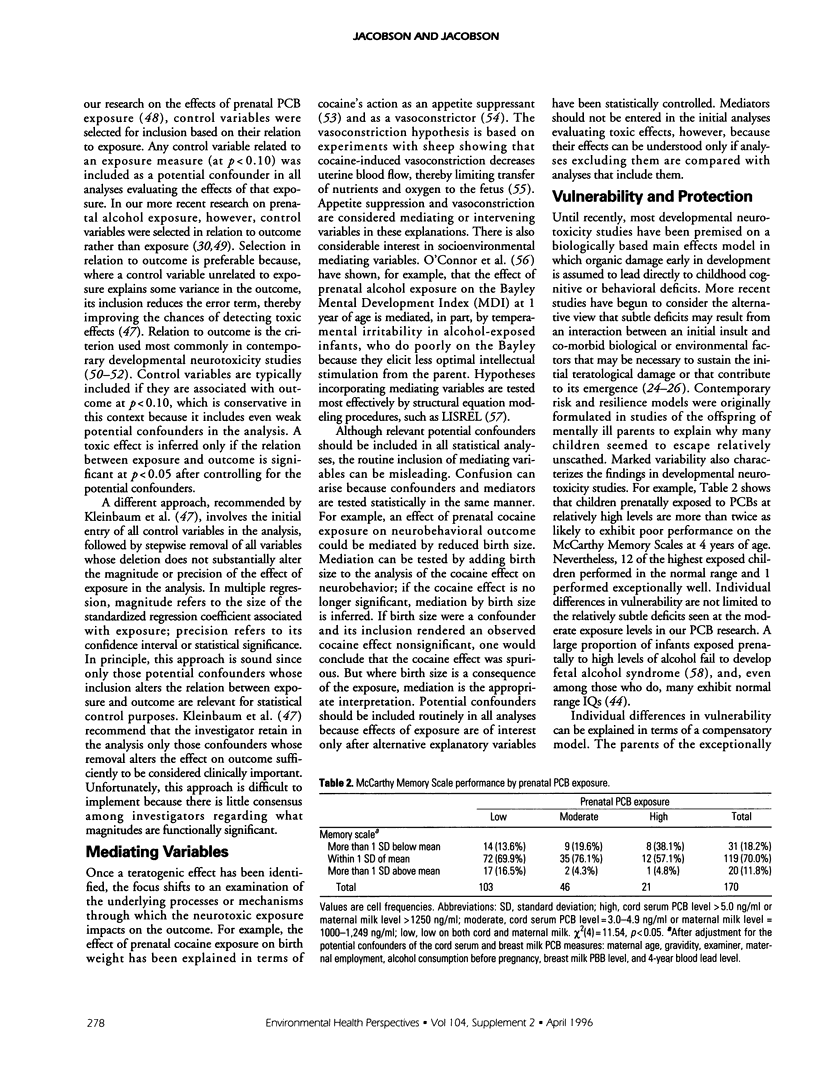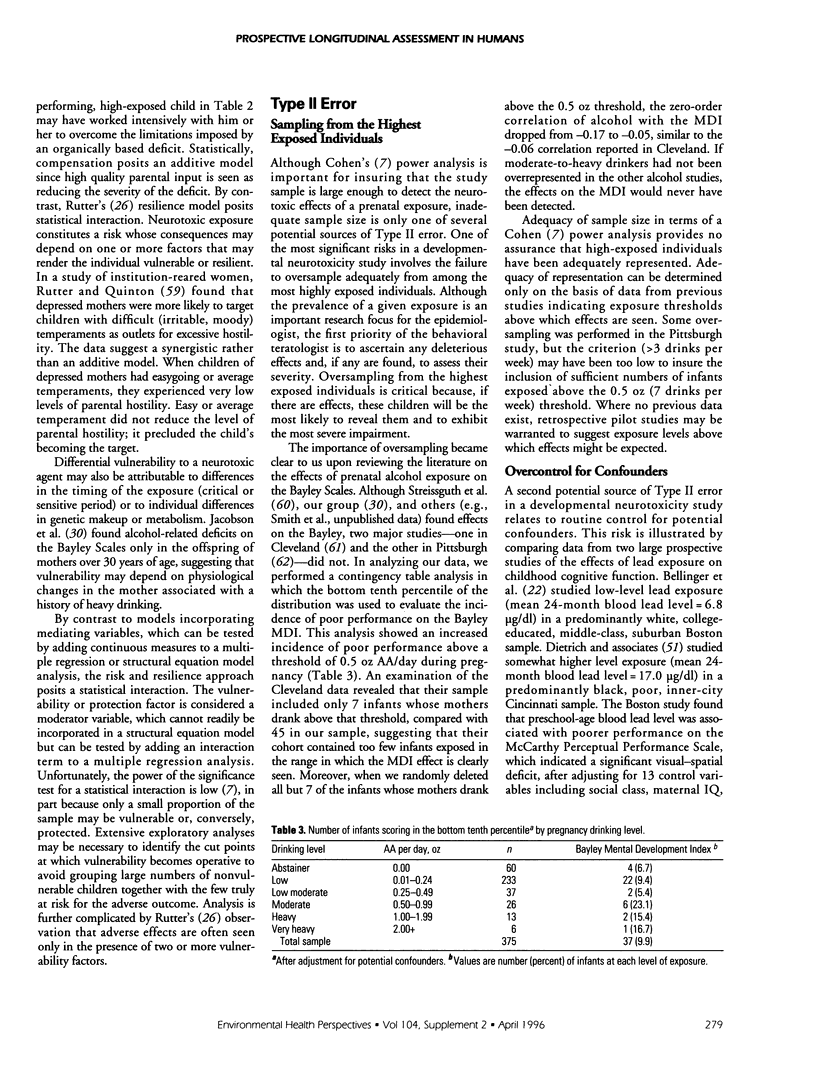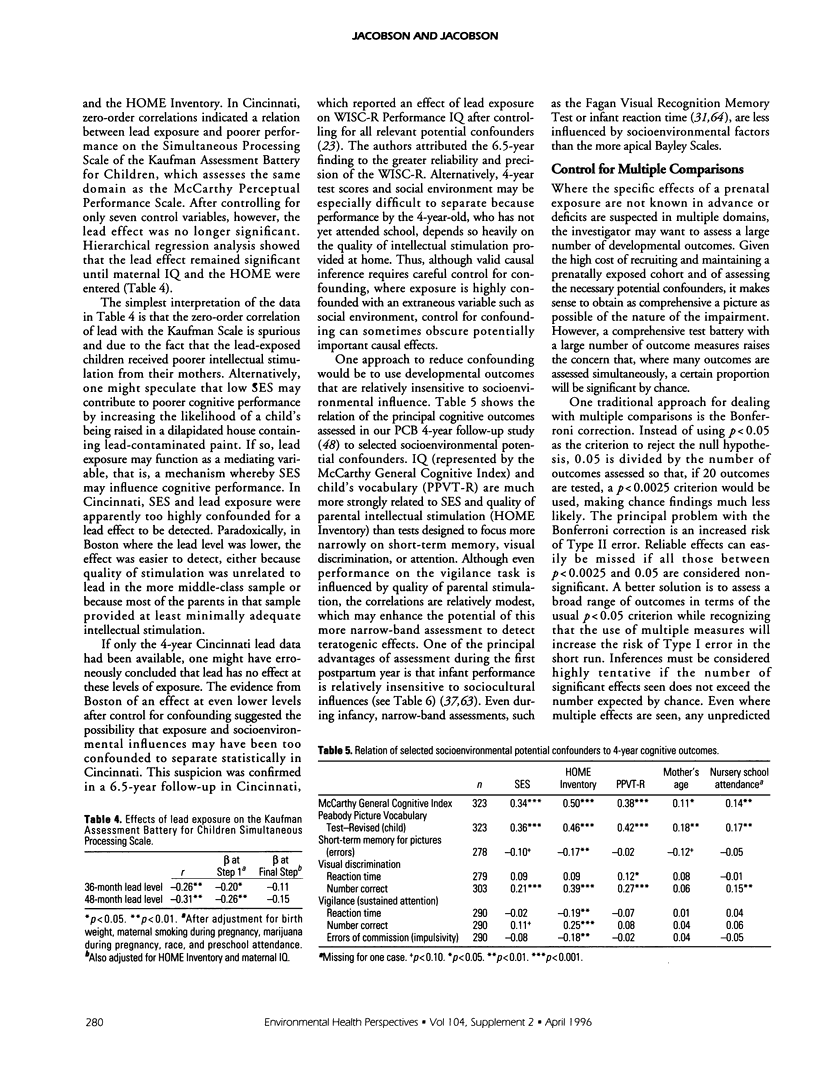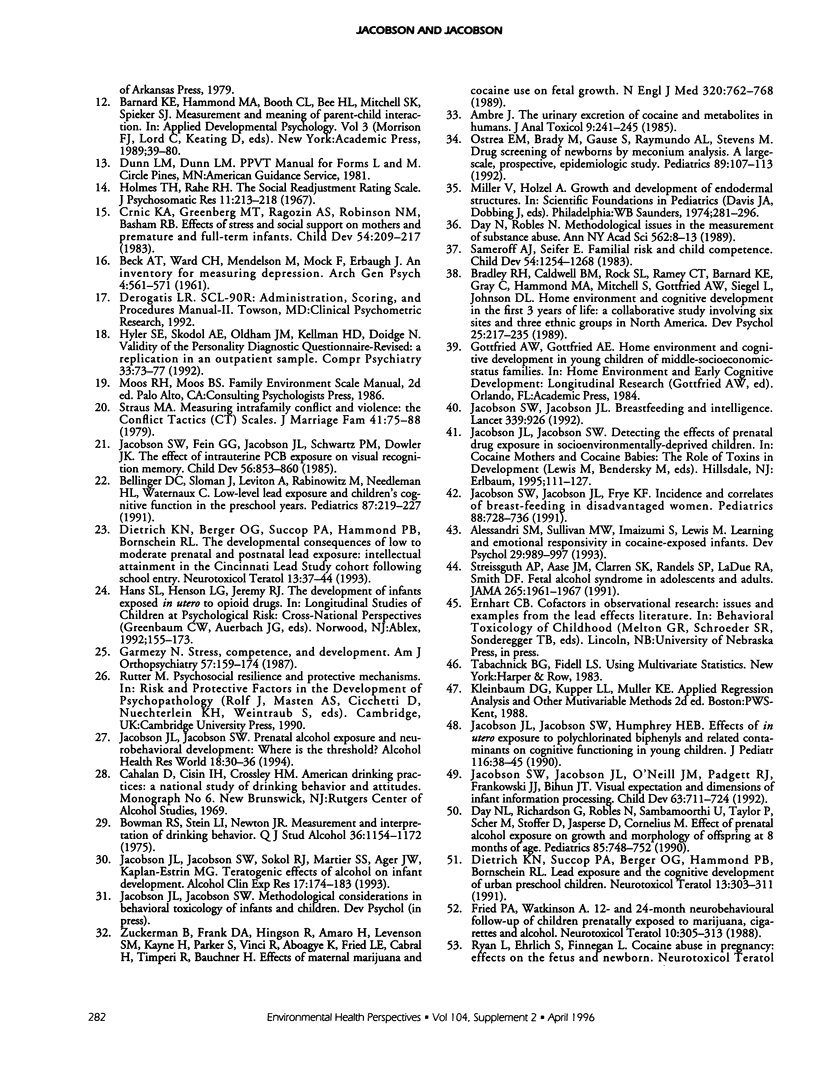Abstract
Methodological issues in the design of prospective, longitudinal studies of developmental neurotoxicity in humans are reviewed. A comprehensive assessment of potential confounding influences is important in these studies because inadequate assessment of confounders can threaten the validity of causal inferences drawn from the data. Potential confounders typically include demographic background variables, alcohol and smoking during pregnancy, the quality of parental stimulation, the child's age at test, and the examiner. Exposure to other substances is assessed where significant exposure is expected in the target population. In most studies, control variables even weakly related to outcome are included in all multivariate statistical analyses, and a toxic effect is inferred only if the effect of exposure is significant after controlling for the potential confounders. Once a neurotoxic effect has been identified, suspected mediating variables may be added to the analysis to examine underlying processes or mechanisms through which the exposure may impact on developmental outcome. Individual differences in vulnerability may be examined in terms of either an additive compensatory model or a synergistic "risk and resilience" approach. Failure to detect real effects (Type II error) is of particular concern in these studies because public policy considerations make it likely that negative findings will be interpreted to mean that the exposure is safe. Important sources of Type II error include inadequate representation of highly exposed individuals, overcontrol for confounders, and inappropriate correction for multiple comparisons. Given the high cost and complexity of prospective, longitudinal investigations, cross-sectional pilot studies focusing on highly exposed individuals can be valuable for the initial identification of salient domains of impairment.
Full text
PDF








Selected References
These references are in PubMed. This may not be the complete list of references from this article.
- Ambre J. The urinary excretion of cocaine and metabolites in humans: a kinetic analysis of published data. J Anal Toxicol. 1985 Nov-Dec;9(6):241–245. doi: 10.1093/jat/9.6.241. [DOI] [PubMed] [Google Scholar]
- Aronson M., Kyllerman M., Sabel K. G., Sandin B., Olegård R. Children of alcoholic mothers. Developmental, perceptual and behavioural characteristics as compared to matched controls. Acta Paediatr Scand. 1985 Jan;74(1):27–35. doi: 10.1111/j.1651-2227.1985.tb10916.x. [DOI] [PubMed] [Google Scholar]
- BECK A. T., WARD C. H., MENDELSON M., MOCK J., ERBAUGH J. An inventory for measuring depression. Arch Gen Psychiatry. 1961 Jun;4:561–571. doi: 10.1001/archpsyc.1961.01710120031004. [DOI] [PubMed] [Google Scholar]
- Bellinger D., Sloman J., Leviton A., Rabinowitz M., Needleman H. L., Waternaux C. Low-level lead exposure and children's cognitive function in the preschool years. Pediatrics. 1991 Feb;87(2):219–227. [PubMed] [Google Scholar]
- Bowman R. S., Stein L. I., Newton J. R. Measurement and interpretation of drinking behavior. I. On measuring patterns of alcohol consumption. II. Relationships between drinking behavior and social adjustment in a sample of problem drinkers. J Stud Alcohol. 1975 Sep;36(9):1154–1172. doi: 10.15288/jsa.1975.36.1154. [DOI] [PubMed] [Google Scholar]
- Butcher R. E. Behavioral testing as a method for assessing risk. Environ Health Perspect. 1976 Dec;18:75–78. doi: 10.1289/ehp.761875. [DOI] [PMC free article] [PubMed] [Google Scholar]
- Crnic K. A., Greenberg M. T., Ragozin A. S., Robinson N. M., Basham R. B. Effects of stress and social support on mothers and premature and full-term infants. Child Dev. 1983 Feb;54(1):209–217. [PubMed] [Google Scholar]
- Day N. L., Richardson G., Robles N., Sambamoorthi U., Taylor P., Scher M., Stoffer D., Jasperse D., Cornelius M. Effect of prenatal alcohol exposure on growth and morphology of offspring at 8 months of age. Pediatrics. 1990 May;85(5):748–752. [PubMed] [Google Scholar]
- Day N. L., Robles N. Methodological issues in the measurement of substance use. Ann N Y Acad Sci. 1989;562:8–13. doi: 10.1111/j.1749-6632.1989.tb21002.x. [DOI] [PubMed] [Google Scholar]
- Dietrich K. N., Berger O. G., Succop P. A., Hammond P. B., Bornschein R. L. The developmental consequences of low to moderate prenatal and postnatal lead exposure: intellectual attainment in the Cincinnati Lead Study Cohort following school entry. Neurotoxicol Teratol. 1993 Jan-Feb;15(1):37–44. doi: 10.1016/0892-0362(93)90043-n. [DOI] [PubMed] [Google Scholar]
- Frank D. A., Bauchner H., Parker S., Huber A. M., Kyei-Aboagye K., Cabral H., Zuckerman B. Neonatal body proportionality and body composition after in utero exposure to cocaine and marijuana. J Pediatr. 1990 Oct;117(4):622–626. doi: 10.1016/s0022-3476(05)80702-4. [DOI] [PubMed] [Google Scholar]
- Fried P. A., Watkinson B. 12- and 24-month neurobehavioural follow-up of children prenatally exposed to marihuana, cigarettes and alcohol. Neurotoxicol Teratol. 1988 Jul-Aug;10(4):305–313. doi: 10.1016/0892-0362(88)90032-3. [DOI] [PubMed] [Google Scholar]
- Garmezy N. Stress, competence, and development: continuities in the study of schizophrenic adults, children vulnerable to psychopathology, and the search for stress-resistant children. Am J Orthopsychiatry. 1987 Apr;57(2):159–174. doi: 10.1111/j.1939-0025.1987.tb03526.x. [DOI] [PubMed] [Google Scholar]
- Greene T., Ernhart C. B., Ager J., Sokol R., Martier S., Boyd T. Prenatal alcohol exposure and cognitive development in the preschool years. Neurotoxicol Teratol. 1991 Jan-Feb;13(1):57–68. doi: 10.1016/0892-0362(91)90028-u. [DOI] [PubMed] [Google Scholar]
- Holmes T. H., Rahe R. H. The Social Readjustment Rating Scale. J Psychosom Res. 1967 Aug;11(2):213–218. doi: 10.1016/0022-3999(67)90010-4. [DOI] [PubMed] [Google Scholar]
- Hyler S. E., Skodol A. E., Oldham J. M., Kellman H. D., Doidge N. Validity of the Personality Diagnostic Questionnaire-Revised: a replication in an outpatient sample. Compr Psychiatry. 1992 Mar-Apr;33(2):73–77. doi: 10.1016/0010-440x(92)90001-7. [DOI] [PubMed] [Google Scholar]
- Jacobson J. L., Jacobson S. W., Humphrey H. E. Effects of in utero exposure to polychlorinated biphenyls and related contaminants on cognitive functioning in young children. J Pediatr. 1990 Jan;116(1):38–45. doi: 10.1016/s0022-3476(05)81642-7. [DOI] [PubMed] [Google Scholar]
- Jacobson J. L., Jacobson S. W., Sokol R. J., Martier S. S., Ager J. W., Kaplan-Estrin M. G. Teratogenic effects of alcohol on infant development. Alcohol Clin Exp Res. 1993 Feb;17(1):174–183. doi: 10.1111/j.1530-0277.1993.tb00744.x. [DOI] [PubMed] [Google Scholar]
- Jacobson S. W., Fein G. G., Jacobson J. L., Schwartz P. M., Dowler J. K. The effect of intrauterine PCB exposure on visual recognition memory. Child Dev. 1985 Aug;56(4):853–860. [PubMed] [Google Scholar]
- Jacobson S. W., Jacobson J. L. Breastfeeding and intelligence. Lancet. 1992 Apr 11;339(8798):926–926. doi: 10.1016/0140-6736(92)90962-3. [DOI] [PubMed] [Google Scholar]
- Jacobson S. W., Jacobson J. L., Frye K. F. Incidence and correlates of breast-feeding in socioeconomically disadvantaged women. Pediatrics. 1991 Oct;88(4):728–736. [PubMed] [Google Scholar]
- Jacobson S. W., Jacobson J. L., O'Neill J. M., Padgett R. J., Frankowski J. J., Bihun J. T. Visual expectation and dimensions of infant information processing. Child Dev. 1992 Jun;63(3):711–724. [PubMed] [Google Scholar]
- Jacobson S. W., Jacobson J. L., Sokol R. J. Effects of fetal alcohol exposure on infant reaction time. Alcohol Clin Exp Res. 1994 Oct;18(5):1125–1132. doi: 10.1111/j.1530-0277.1994.tb00092.x. [DOI] [PubMed] [Google Scholar]
- Jacobson S. W., Jacobson J. L., Sokol R. J., Martier S. S., Ager J. W., Kaplan M. G. Maternal recall of alcohol, cocaine, and marijuana use during pregnancy. Neurotoxicol Teratol. 1991 Sep-Oct;13(5):535–540. doi: 10.1016/0892-0362(91)90062-2. [DOI] [PubMed] [Google Scholar]
- Kuzma J. W., Kissinger D. G. Patterns of alcohol and cigarette use in pregnancy. Neurobehav Toxicol Teratol. 1981 Summer;3(2):211–221. [PubMed] [Google Scholar]
- Molfese V. J., Thomson B. K., Beadnell B., Bricker M. C., Manion L. G. Perinatal risk screening and infant outcome. Can predictions be improved with composite scales? J Reprod Med. 1987 Aug;32(8):569–576. [PubMed] [Google Scholar]
- Needleman H. L., Gunnoe C., Leviton A., Reed R., Peresie H., Maher C., Barrett P. Deficits in psychologic and classroom performance of children with elevated dentine lead levels. N Engl J Med. 1979 Mar 29;300(13):689–695. doi: 10.1056/NEJM197903293001301. [DOI] [PubMed] [Google Scholar]
- Ostrea E. M., Jr, Brady M., Gause S., Raymundo A. L., Stevens M. Drug screening of newborns by meconium analysis: a large-scale, prospective, epidemiologic study. Pediatrics. 1992 Jan;89(1):107–113. [PubMed] [Google Scholar]
- Richardson G. A., Day N. L. Maternal and neonatal effects of moderate cocaine use during pregnancy. Neurotoxicol Teratol. 1991 Jul-Aug;13(4):455–460. doi: 10.1016/0892-0362(91)90095-e. [DOI] [PubMed] [Google Scholar]
- Riley E. P. The long-term behavioral effects of prenatal alcohol exposure in rats. Alcohol Clin Exp Res. 1990 Oct;14(5):670–673. doi: 10.1111/j.1530-0277.1990.tb01225.x. [DOI] [PubMed] [Google Scholar]
- Sameroff A. J., Seifer R. Familial risk and child competence. Child Dev. 1983 Oct;54(5):1254–1268. [PubMed] [Google Scholar]
- Shaywitz S. E., Cohen D. J., Shaywitz B. A. Behavior and learning difficulties in children of normal intelligence born to alcoholic mothers. J Pediatr. 1980 Jun;96(6):978–982. doi: 10.1016/s0022-3476(80)80621-4. [DOI] [PubMed] [Google Scholar]
- Sokol R. J., Ager J., Martier S., Debanne S., Ernhart C., Kuzma J., Miller S. I. Significant determinants of susceptibility to alcohol teratogenicity. Ann N Y Acad Sci. 1986;477:87–102. doi: 10.1111/j.1749-6632.1986.tb40323.x. [DOI] [PubMed] [Google Scholar]
- Spyker J. M. Assessing the impact of low level chemicals on development: behavioral and latent effects. Fed Proc. 1975 Aug;34(9):1835–1844. [PubMed] [Google Scholar]
- Streissguth A. P., Aase J. M., Clarren S. K., Randels S. P., LaDue R. A., Smith D. F. Fetal alcohol syndrome in adolescents and adults. JAMA. 1991 Apr 17;265(15):1961–1967. [PubMed] [Google Scholar]
- Streissguth A. P., Barr H. M., Martin D. C., Herman C. S. Effects of maternal alcohol, nicotine, and caffeine use during pregnancy on infant mental and motor development at eight months. Alcohol Clin Exp Res. 1980 Apr;4(2):152–164. doi: 10.1111/j.1530-0277.1980.tb05630.x. [DOI] [PubMed] [Google Scholar]
- Weiss B., Spyker J. M. The susceptibility of the fetus and child to chemical pollutants. Behavioral implications of prenatal and early postnatal exposure to chemical pollutants. Pediatrics. 1974 May;53(5):851–859. [PubMed] [Google Scholar]
- Woods J. R., Jr, Plessinger M. A., Clark K. E. Effect of cocaine on uterine blood flow and fetal oxygenation. JAMA. 1987 Feb 20;257(7):957–961. [PubMed] [Google Scholar]
- Zuckerman B., Frank D. A., Hingson R., Amaro H., Levenson S. M., Kayne H., Parker S., Vinci R., Aboagye K., Fried L. E. Effects of maternal marijuana and cocaine use on fetal growth. N Engl J Med. 1989 Mar 23;320(12):762–768. doi: 10.1056/NEJM198903233201203. [DOI] [PubMed] [Google Scholar]


